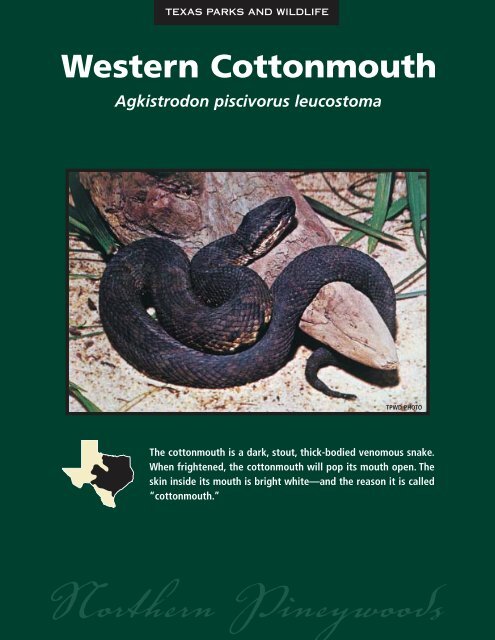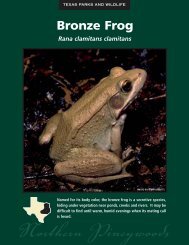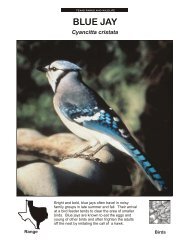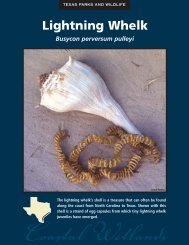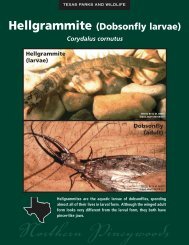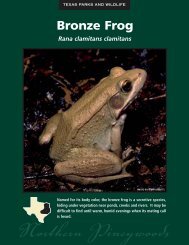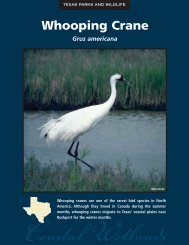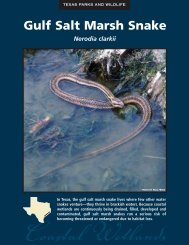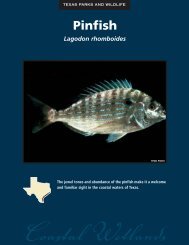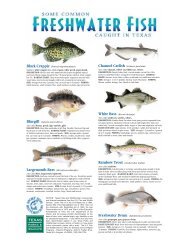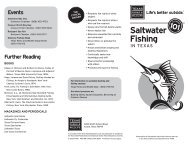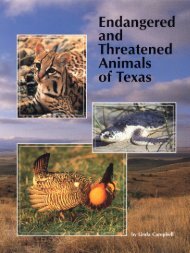Western Cottonmouth - The State of Water
Western Cottonmouth - The State of Water
Western Cottonmouth - The State of Water
- No tags were found...
You also want an ePaper? Increase the reach of your titles
YUMPU automatically turns print PDFs into web optimized ePapers that Google loves.
TEXAS PARKS AND WILDLIFE<strong>Western</strong> <strong>Cottonmouth</strong>Agkistrodon piscivorus leucostomaTPWD PHOTO<strong>The</strong> cottonmouth is a dark, stout, thick-bodied venomous snake.When frightened, the cottonmouth will pop its mouth open. <strong>The</strong>skin inside its mouth is bright white—and the reason it is called“cottonmouth.”
<strong>Western</strong> <strong>Cottonmouth</strong>Agkistrodon piscivorus leucostomaAPPEARANCELength: Most adults average 30-42 inches (76-106.7 cm)Distinguishing Characteristics• Dark, grayish-brown with little or no markings; very oldcottonmouths may be entirely black• White skin inside their mouth• Broad, flat head distinctly wider than neck• Elliptical (cat-like) pupil. By day the pupil appears as a narrowslit; at night the pupil is wide and may even look round.LIFE HISTORYRange:Diet:Predators:Sexual maturity:Mating season:Eggs:Incubation:Young:Life span:Southern Illinois south to Alabama, westto Oklahoma and Central TexasFrogs, fish, smaller snakes (includingother cottonmouths), small water birdsand small mammals, carrion and sometimesfish on stringersOther snakes and humansFemales at three years; males at two yearsSpring<strong>Cottonmouth</strong>s, like other pit vipers, donot lay eggs. Instead the eggs are keptinside the female’s body until the eggsare ready to “hatch.”Because fertilization and pregnancy arebased on the female’s physical condition,gestation periods vary from snaketo snake and season to season.<strong>Cottonmouth</strong>s are born from earlyAugust until early October.Females bear only three to 12 <strong>of</strong>fspringper litter. Newborn cottonmouths are 6to 11 inches (15.2 to 28 cm) long. <strong>The</strong>yhave brownish or reddish bodies withlines that are wide on the sides and narrowacross the back. <strong>Cottonmouth</strong>s areborn with yellow or greenish-gray tailtips and come complete with functionalfangs and a full supply <strong>of</strong> venom. DONOT TOUCH a young cottonmouth!Less than ten yearsHABITAT<strong>Western</strong> cottonmouths prefer lowland swamps, lakes, rivers,sloughs, irrigation ditches, rice fields and salt marshes, but arenot confined to living in moist habitats.BEHAVIOR• When swimming, the cottonmouth holds its head abovewater with most <strong>of</strong> its body barely touching the surface.• <strong>Cottonmouth</strong>s are nocturnal, most active at night.• <strong>The</strong> young wiggle their tails so that the tip appears to be asmall worm. When small frogs and lizards see the wrigglingtail, they think it’s something to eat and rush forward to eatit, only to be eaten by the baby cottonmouth.• <strong>Cottonmouth</strong>s eat other snakes, including their own kind. <strong>The</strong>only time more than one cottonmouth would be in the sameplace at the same time is: 1) mating season, 2) female givingbirth, or 3) one cottonmouth is eating another.NOW YOU KNOW!• Also called ‘water moccasin,” cottonmouths CAN bite underwater,but their prey is fish. If they could not bite underwater,they would starve.• <strong>Cottonmouth</strong>s avoid contact with humans or any other possiblepredator. (All those stories about swarming cottonmouthsattacking people are myths!) But like any animal, whenthreatened, cottonmouths will attack to protect themselves.• In some places, especially around woodland ponds, you canfind western cottonmouths every few yards. Sometimes, youcan smell their musky odor in the air.• Heat sensors on either side <strong>of</strong> the snake’s face detect heatand help the cottonmouth to find food.WESTERN COTTONMOUTHSAND PEOPLEOnly 7% <strong>of</strong> all Texas snakebite cases involve cottonmouths.Throughout the United <strong>State</strong>s, less than 1% <strong>of</strong> all deaths bysnakebite have been caused by cottonmouths. While the oddsmake it seem unlikely to die from a cottonmouth bite, nonetheless,their venom can still cause severe bleeding and considerabledamage to tissue. DO NOT TOUCH and if bitten, seekimmediate medical attention!As our population continues to grow, and wildlife habitat isdeveloped, encounters with venomous snakes are going tooccur. Many <strong>of</strong> these encounters occur around the home, withthe result that incidents <strong>of</strong> bites close to home are statisticallyhigh. Keep wood and brush piles, trash dumps and livestockpens as far as possible from the residence. When working inthese areas, exercise caution. Never put an arm or leg intosomething if you cannot see the bottom. Use a flashlightwhen moving about at night, even in your home yard. Animalburrows make excellent habitat for snakes—don’t reach inwithout first checking.PWD LF D0200-848T (8/02) NOTICE: Texas Parks and Wildlife Department receives federal financial assistance from the U.S. Fish and Wildlife Service. Under Title VI <strong>of</strong> the Civil Rights Act <strong>of</strong> 1964, Section 504 <strong>of</strong> the RehabilitationAct <strong>of</strong> 1973, Title II <strong>of</strong> the Americans with Disabilities Act <strong>of</strong> 1990, the Age Discrimination Act <strong>of</strong> 1975, and Title IX <strong>of</strong> the Education Amendments <strong>of</strong> 1972, the U.S. Department <strong>of</strong> the Interior and its bureaus prohibit discriminationon the basis <strong>of</strong> race, color, national origin, age, disability or sex (in educational programs). If you believe that you have been discriminated against in any Texas Parks and Wildlife Department program, activity, or facility, or if youdesire further information, please call or write: <strong>The</strong> U.S. Fish and Wildlife Service, Office for Diversity and Civil Rights Programs - External Programs, 4040 N. Fairfax Drive, Webb 300, Arlington, VA 22203, (703) 358-1724.


